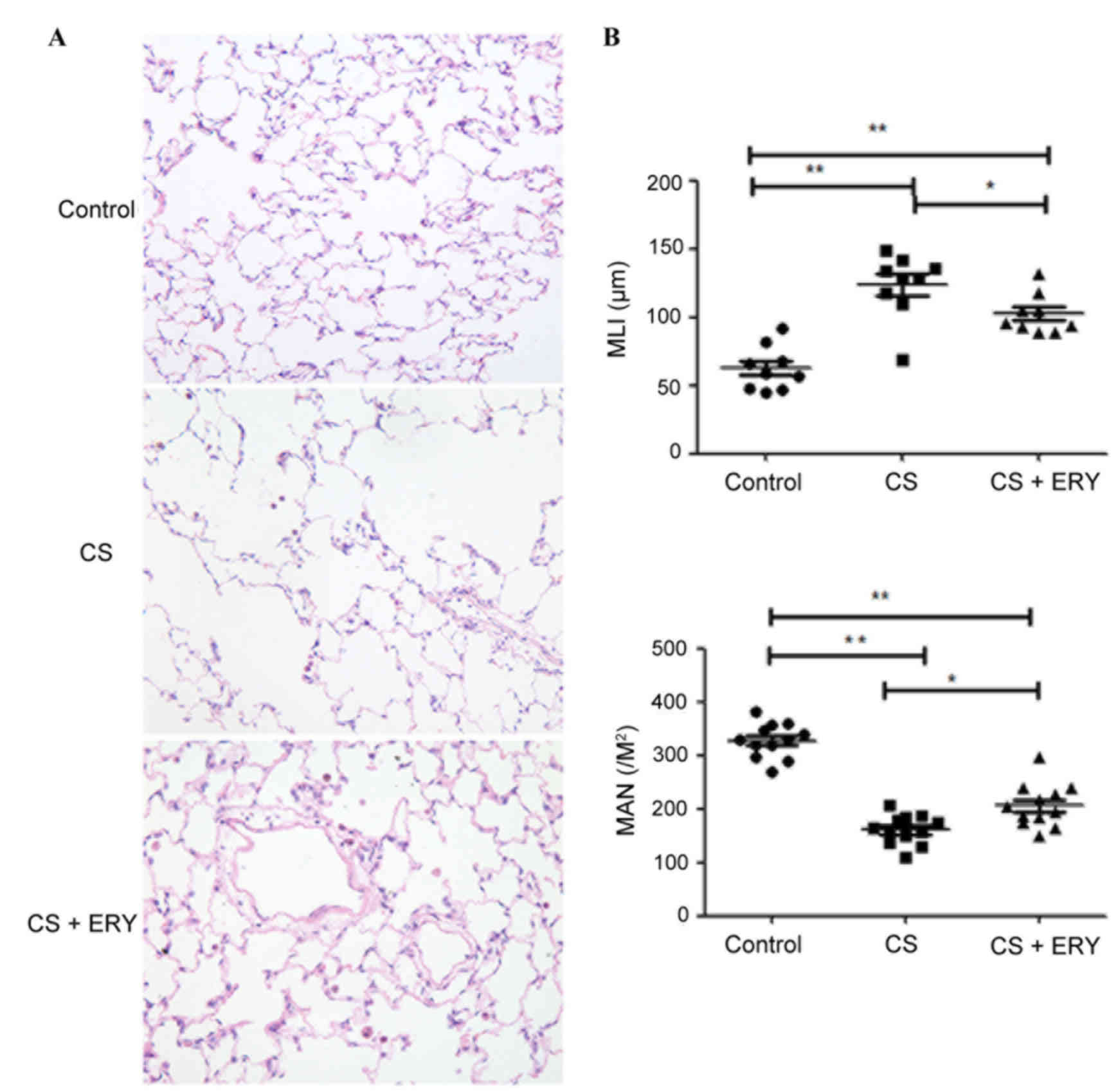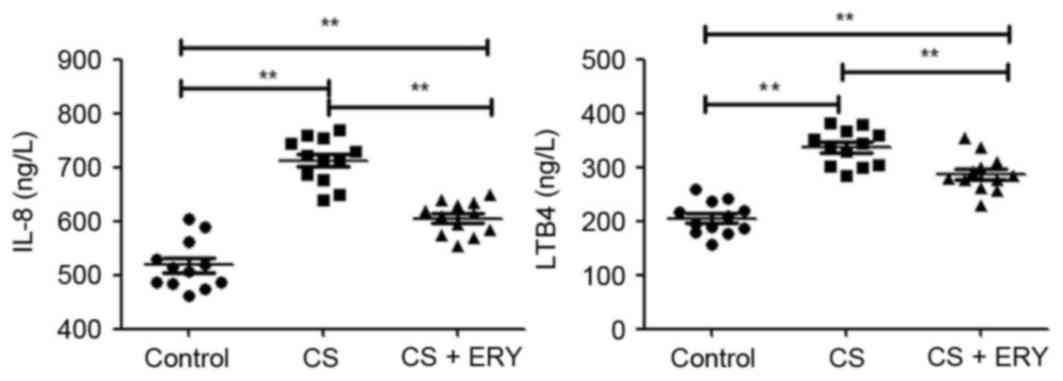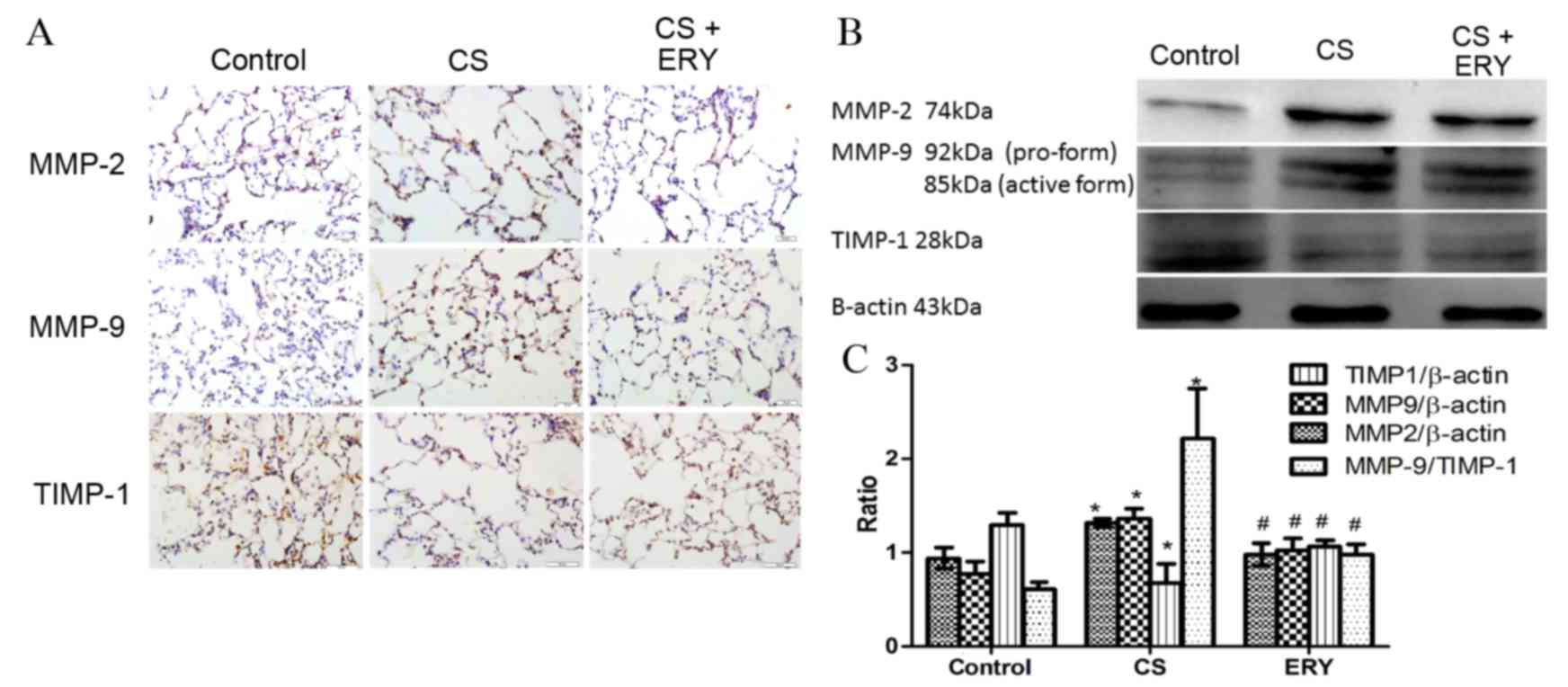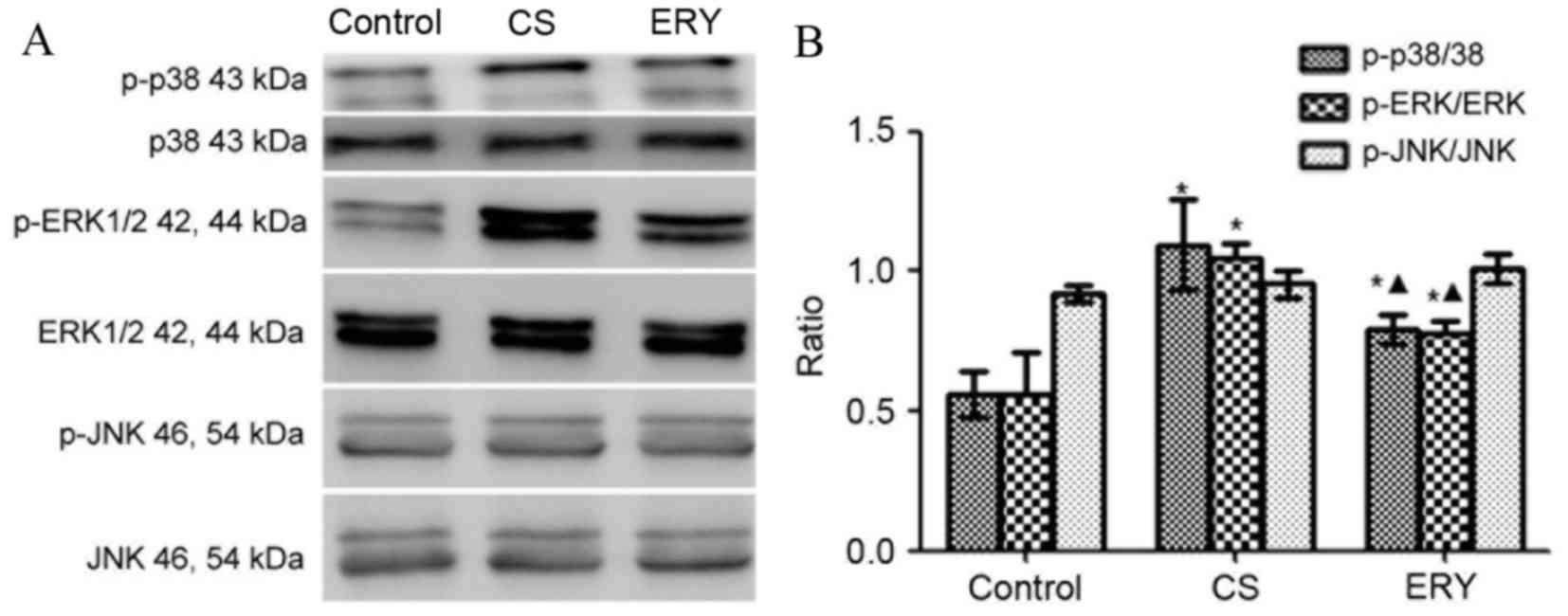|
1
|
Celli BR and MacNee W: ATS/ERS Task Force:
Standards for the diagnosis and treatment of patients with COPD: A
summary of the ATS/ERS position paper. Eur Respir J. 23:932–946.
2004. View Article : Google Scholar : PubMed/NCBI
|
|
2
|
Nowak D, Berger K, Lippert B, Kilgert K,
Caeser M and Sandtmann R: Epidemiology and health economics of COPD
across Europe: A critical analysis. Treat Respir Med. 4:381–395.
2005. View Article : Google Scholar : PubMed/NCBI
|
|
3
|
Fragoso CA: Epidemiology of chronic
obstructive pulmonary disease (COPD) in aging populations. COPD.
13:125–129. 2016. View Article : Google Scholar : PubMed/NCBI
|
|
4
|
Chapman KR, Mannino DM, Soriano JB,
Vermeire PA, Buist AS, Thun MJ, Connell C, Jemal A, Lee TA,
Miravitlles M, et al: Epidemiology and costs of chronic obstructive
pulmonary disease. Eur Respir J. 27:188–207. 2006. View Article : Google Scholar : PubMed/NCBI
|
|
5
|
Stockley RA, O'Brien C, Pye A and Hill SL:
Relationship of sputum color to nature and outpatient management of
acute exacerbations of COPD. Chest. 117:1638–1645. 2000. View Article : Google Scholar : PubMed/NCBI
|
|
6
|
Spurzem JR and Rennard SI: Pathogenesis of
COPD. Semin Respir Crit Care Med. 26:142–153. 2005. View Article : Google Scholar : PubMed/NCBI
|
|
7
|
Kwiatkowska S, Noweta K, Zieba M, Nowak D
and Bialasiewicz P: Enhanced exhalation of matrix
metalloproteinase-9 and tissue inhibitor of metalloproteinase-1 in
patients with COPD exacerbation: A prospective study. Respiration.
84:231–241. 2012. View Article : Google Scholar : PubMed/NCBI
|
|
8
|
Mocchegiani E, Giacconi R and Costarelli
L: Metalloproteases/anti-metalloproteases imbalance in chronic
obstructive pulmonary disease: Genetic factors and treatment
implications. Curr Opin Pulm Med. 17:(Suppl 1). S11–S19. 2011.
View Article : Google Scholar : PubMed/NCBI
|
|
9
|
Kanoh S and Rubin BK: Mechanisms of action
and clinical application of macrolides as immunomodulatory
medications. Clin Microbiol Rev. 23:590–615. 2010. View Article : Google Scholar : PubMed/NCBI
|
|
10
|
Mazzei T, Mini E, Novelli A and Periti P:
Chemistry and mode of action of macrolides. J Antimicrob Chemother.
31:(Suppl C). S1–S9. 1993. View Article : Google Scholar
|
|
11
|
Perry DK, Hand WL, Edmondson DE and
Lambeth JD: Role of phospholipase D-derived diradylglycerol in the
activation of the human neutrophil respiratory burst oxidase.
Inhibition by phosphatidic acid phosphohydrolase inhibitors. J
Immunol. 149:2749–2758. 1992.PubMed/NCBI
|
|
12
|
Zhou Y, Tan X, Kuang W, Liu L and Wan L:
Erythromycin ameliorates cigarette-smoke-induced emphysema and
inflammation in rats. Transl Res. 159:464–472. 2012. View Article : Google Scholar : PubMed/NCBI
|
|
13
|
Birrell MA, Wong S, Catley MC and Belvisi
MG: Impact of tobacco-smoke on key signaling pathways in the innate
immune response in lung macrophages. J Cell Physiol. 214:27–37.
2008. View Article : Google Scholar : PubMed/NCBI
|
|
14
|
Moretto N, Facchinetti F, Southworth T,
Civelli M, Singh D and Patacchini R: alpha, beta-Unsaturated
aldehydes contained in cigarette smoke elicit IL-8 release in
pulmonary cells through mitogen-activated protein kinases. Am J
Physiol Lung Cell Mol Physiol. 296:L839–L848. 2009. View Article : Google Scholar : PubMed/NCBI
|
|
15
|
Cheng SE, Luo SF, Jou MJ, Lin CC, Kou YR,
Lee IT, Hsieh HL and Yang CM: Cigarette smoke extract induces
cytosolic phospholipase A2 expression via NADPH oxidase, MAPKs,
AP-1, and NF-kappaB in human tracheal smooth muscle cells. Free
Radic Biol Med. 46:948–960. 2009. View Article : Google Scholar : PubMed/NCBI
|
|
16
|
Zheng H, Liu Y, Huang T, Fang Z, Li G and
He S: Development and characterization of a rat model of chronic
obstructive pulmonary disease (COPD) induced by sidestream
cigarette smoke. Toxicol Lett. 189:225–234. 2009. View Article : Google Scholar : PubMed/NCBI
|
|
17
|
Yin Y, Hou G, Li E, Wang Q and Kang J:
PPARγ agonists regulate tobacco smoke-induced Toll like receptor 4
expression in alveolar macrophages. Respir Res. 15:282014.
View Article : Google Scholar : PubMed/NCBI
|
|
18
|
Rabe KF, Hurd S, Anzueto A, Barnes PJ,
Buist SA, Calverley P, Fukuchi Y, Jenkins C, Rodriguez-Roisin R,
van Weel C, et al: Global strategy for the diagnosis, management,
and prevention of chronic obstructive pulmonary disease: GOLD
executive summary. Am J Respir Crit Care Med. 176:532–555. 2007.
View Article : Google Scholar : PubMed/NCBI
|
|
19
|
Atkinson JJ, Lutey BA, Suzuki Y, Toennies
HM, Kelley DG, Kobayashi DK, Ijem WG, Deslee G, Moore CH, Jacobs
ME, et al: The role of matrix metalloproteinase-9 in cigarette
smoke-induced emphysema. Am J Respir Crit Care Med. 183:876–884.
2011. View Article : Google Scholar : PubMed/NCBI
|
|
20
|
Kanai K, Asano K, Hisamitsu T and Suzaki
H: Suppression of matrix metalloproteinase production from nasal
fibroblasts by macrolide antibiotics in vitro. Eur Respir J.
23:671–678. 2004. View Article : Google Scholar : PubMed/NCBI
|
|
21
|
Ci X, Chu X, Xu X, Li H and Deng X:
Short-term roxithromycin treatment attenuates airway inflammation
via MAPK/NF-κB activation in a mouse model of allergic asthma.
Inflamm Res. 61:749–758. 2012. View Article : Google Scholar : PubMed/NCBI
|
|
22
|
Willems-Widyastuti A, Vanaudenaerde BM,
Vos R, Dilisen E, Verleden SE, De Vleeschauwer SI, Vaneylen A, Mooi
WJ, de Boer WI, Sharma HS and Verleden GM: Azithromycin attenuates
fibroblast growth factors induced vascular endothelial growth
factor via p38(MAPK) signaling in human airway smooth muscle cells.
Cell Biochem Biophys. 67:331–339. 2013. View Article : Google Scholar : PubMed/NCBI
|
|
23
|
Singh D, Smyth L, Borrill Z, Sweeney L and
Tal-Singer R: A randomized, placebo-controlled study of the effects
of the p38 MAPK inhibitor SB-681323 on blood biomarkers of
inflammation in COPD patients. J Clin Pharmacol. 50:94–100. 2010.
View Article : Google Scholar : PubMed/NCBI
|
|
24
|
Goven D, Boutten A, Leçon-Malas V,
Boczkowski J and Bonay M: Prolonged cigarette smoke exposure
decreases heme oxygenase-1 and alters Nrf2 and Bach1 expression in
human macrophages: Roles of the MAP kinases ERK(1/2) and JNK. FEBS
Lett. 583:3508–3518. 2009. View Article : Google Scholar : PubMed/NCBI
|
|
25
|
Chung KF: p38 mitogen-activated protein
kinase pathways in asthma and COPD. Chest. 139:1470–1479. 2011.
View Article : Google Scholar : PubMed/NCBI
|
|
26
|
Barnes PJ and Adcock IM: Glucocorticoid
resistance in inflammatory diseases. Lancet. 373:1905–1917. 2009.
View Article : Google Scholar : PubMed/NCBI
|
|
27
|
Chen X, Zeng S, Zou J, Chen Y, Yue Z, Gao
Y, Zhang L, Cao W and Liu P: Rapamycin attenuated cardiac
hypertrophy induced by isoproterenol and maintained energy
homeostasis via inhibiting NF-κB activation. Mediators Inflamm.
2014:8687532014. View Article : Google Scholar : PubMed/NCBI
|
|
28
|
Aghai ZH, Kode A, Saslow JG, Nakhla T,
Farhath S, Stahl GE, Eydelman R, Strande L, Leone P and Rahman I:
Azithromycin suppresses activation of nuclear factor-kappa B and
synthesis of pro-inflammatory cytokines in tracheal aspirate cells
from premature infants. Pediatr Res. 62:483–488. 2007. View Article : Google Scholar : PubMed/NCBI
|
|
29
|
Matsumura Y, Mitani A, Suga T, Kamiya Y,
Kikuchi T, Tanaka S, Aino M and Noguchi T: Azithromycin may inhibit
interleukin-8 through suppression of Rac1 and a nuclear
factor-kappa B pathway in KB cells stimulated with
lipopolysaccharide. J Periodontol. 82:1623–1631. 2011. View Article : Google Scholar : PubMed/NCBI
|
|
30
|
Kobayashi Y, Wada H, Rossios C, Takagi D,
Higaki M, Mikura S, Goto H, Barnes PJ and Ito K: A novel macrolide
solithromycin exerts superior anti-inflammatory effect via NF-κB
inhibition. J Pharmacol Exp Ther. 345:76–84. 2013. View Article : Google Scholar : PubMed/NCBI
|
|
31
|
Aghai ZH, Kode A, Saslow JG, Nakhla T,
Farhath S, Stahl GE, Eydelman R, Strande L, Leone P and Rahman I:
Azithromycin suppresses activation of nuclear factor-kappa B and
synthesis of pro-inflammatory cytokines in tracheal aspirate cells
from premature infants. Pediatr Res. 62:483–488. 2007. View Article : Google Scholar : PubMed/NCBI
|
|
32
|
Marumo S, Hoshino Y, Kiyokawa H, Tanabe N,
Sato A, Ogawa E, Muro S, Hirai T and Mishima M: p38
mitogen-activated protein kinase determines the susceptibility to
cigarette smoke-induced emphysema in mice. BMC Pulm Med. 14:792014.
View Article : Google Scholar : PubMed/NCBI
|
|
33
|
Abe S, Nakamura H, Inoue S, Takeda H,
Saito H, Kato S, Mukaida N, Matsushima K and Tomoike H:
Interleukin-8 gene repression by clarithromycin is mediated by the
activator protein-1 binding site in human bronchial epithelial
cells. Am J Respir Cell Mol Biol. 22:51–60. 2000. View Article : Google Scholar : PubMed/NCBI
|
|
34
|
Desaki M, Takizawa H, Ohtoshi T, Kasama T,
Kobayashi K, Sunazuka T, Omura S, Yamamoto K and Ito K:
Erythromycin suppresses nuclear factor-kappaB and activator
protein-1 activation in human bronchial epithelial cells. Biochem
Biophys Res Commun. 267:124–128. 2000. View Article : Google Scholar : PubMed/NCBI
|
|
35
|
Kim H, Liu X, Kohyama T, Kobayashi T,
Conner H, Abe S, Fang Q, Wen FQ and Rennard SI: Cigarette smoke
stimulates MMP-1 production by human lung fibroblasts through the
ERK1/2 pathway. COPD. 1:13–23. 2004. View Article : Google Scholar : PubMed/NCBI
|














